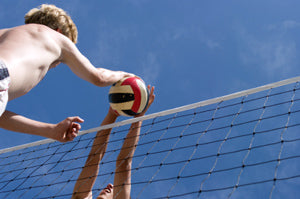How to Block in Beach Volleyball
June 17, 2019

 Blocking is a team’s first line of defense. It is more important to stay true to your blocking scheme than to go for the block because blocking is more about establishing zones for the defense than actually blocking a ball.
Blocking is a team’s first line of defense. It is more important to stay true to your blocking scheme than to go for the block because blocking is more about establishing zones for the defense than actually blocking a ball.
Ready Position
For blockers, time is of the essence. A single second — or in some cases, even a fraction of a second — could be the difference between stuffing the opponent’s attack and air-balling. As a result, maintaining efficiency of movement is imperative when blocking. The diagram below illustrates ideal body positioning for blockers; utilizing the stance will allow the blocker to execute the motion efficiently.
Pay special attention to these aspects of the position:
- Knees flexed: Too many beginning blockers get lazy and stand up while waiting to block. This is a definite no-no. Keeping the knees flexed will allow you to elevate much quicker when the opportunity presents itself. Less time spent on the ground means more blocks for you.
- Arms high: Like the minute-men of the American Revolution (see, your history teacher was right, history is relevant to your daily life), blockers must always be ready to spring into action. Make sure to keep the arms high and elbows at chest-level to minimize the amount of time it takes to go from the ready position to blocking.
- Elbows in: Turn the elbows in towards each other so that the bottom of your elbow is pointed at the ground.
Spacing
Touching the net while attempting to block is a violation. The best way to avoid this mishap is to make sure there is sufficient space between your body and the net; half an arm’s length should suffice.
Blocking Technique
Now that you’ve got the ready position down pat, it’s time to get down to the nitty-gritty: Blocking fundamentals. In volleyball, a block is an attempt to prevent an opponent’s attack from crossing the plane of the net.
If a player has assumed the posture outlined in the section above, then blocking is a fairly simple maneuver. To execute a block, jump while simultaneously extending the arms above the head. The purpose of the block is to prevent an opponent’s attack from coming over the net, so it’s important to get the arms as close to the net as possible without touching the net.
Blocking Sequence
Physical tools like extraordinary leaping ability or above average height are an asset to any blocker, but physical attributes can only get you so far. The other half of the blocking equation is the mental aspect.
The NCAA started keeping volleyball stats during the 1981 season. However, information on blocking has not been included in the records since there appeared to be a significant variance in the methods by which blocking statistics were kept.
Volleyball plays develop quickly, so blocking requires the ability to process information in a timely manner (the sooner you can determine the location of the set, the sooner you can set the block). Tracking the development of the play is the most efficient way to obtain this information, and the blocking sequence provides a systematic method for doing just that.
At first glance, the blocking sequence (ball-setter-ball-hitter) seems to be a meaningless smorgasbord of volleyball terms. However, the terms in the sequence refer to specific elements of the play that blockers must identify. That’s why it is a useful tool for narrowing the scope of information a blocker needs to process before deciding where to set the block.
Here’s how the sequence works. When blocking, a hitter must first watch the ball as it comes off the passer’s platform (ball). As the ball begins to descend towards the opposing setter, the blocker will transfer her focus from the ball to the setter (ball-setter). Focusing on the setter at this point will reveal pertinent information. A setter’s tendencies may tip off where she plans to set the ball, or the position of the pass might limit a setter’s options.
Once the ball leaves the setter’s hands, the blocker should quickly shift focus back to the flight path of the ball (ball-setter-ball) to determine where the set will land. As soon as that information is obtained, the blocker will then locate and focus on the hitter (ball-setter-ball-hitter).
Stuff the Block
Few plays in volleyball are more exciting than the stuff block. So memorize the tips listed above and you’ll be a blocking machine in no time flat.



